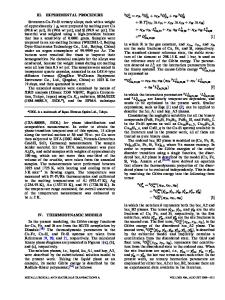A reassessment of the Cr-Fe-Ni system
- PDF / 626,671 Bytes
- 8 Pages / 594 x 774 pts Page_size
- 87 Downloads / 310 Views
I.
INTRODUCTION
T H E Cr-Fe-Ni system is of considerable practical importance, being the basis for austenitic stainless steels. It has been studied experimentally for a long time, and many attempts have been made recently to model its phase relations by thermodynamic methods. The early experimental studies by Wever and Jellinghaus [1~ and Jenkins et al. [2~ were extensive but emphasized the phase equilibria involving the liquid. More recently, there have been a large number of studies of the system with both solid and liquid phases. An early attempt to model the whole system was made by Kaufman and Nesor. [3] In later works, most attention was paid to the a/~/equilibrium. A typical example is the study by Hertzman and Sundman, [4] who first made a very careful assessment of the experimental information on the a / 7 equilibrium and found that their thermodynamic model gave a satisfactory description of the ternary information without introducing any ternary parameters except for those describing the magnetic properties. As a consequence, they also tried to predict the phase equilibria, including the liquid, by extrapolation from the binary systems. They obtained reasonable agreement with experimental information on the univariant equilibrium liquid/a/7. Later, Chuang and Chang tS] reassessed the system, because they had decided to describe the magnetic effect with a different model. Again, they did not apply any ternary parameters except for those describing the magnetic properties. Their results are very similar to those obtained by Hertzman and Sundman. [41 The model for the magnetic contribution applied by Hertzman and Sundman [4] has also been used in more careful assessments of the three binary systems, t6,7,8]When they were combined in a description of the ternary system, the agreement for the solid/liquid equilibria was no longer so good. Gustafson [9J showed that the discrepancy could be improved by introducing a small ternary interaction. It would thus seem that the satisfactory description of the temary information involving the liquid phase, which was obtained by Hertzman and Sundman, t4] was
MATS HILLERT, Professor, and CAIAN QIU, Graduate Student, are with the Department of Physical Metallurgy and Ceramics, the Royal Institute of Technology, S-100 44 Stockholm, Sweden. Manuscript submitted December 12, 1989. METALLURGICAL TRANSACTIONS A
fortuitous. Gustafson [x~ also calculated equilibria with the o- phase. Recently, Kundrat and Elliott t~j reported new measurements of the phase equilibria involving the liquid. They analyzed their own and other information by thermodynamic modeling and found it necessary to introduce ternary parameters in a, ~/, and liquid. However, they paid most attention to the Fe-rich comer, and the plot of the calculated three-phase temperature shows unreasonable results at low Fe contents. Furthermore, they only took into account the equilibria involving the liquid. There is a strong tendency to gather the thermodynamic descriptions of various alloy systems in databanks and us
Data Loading...











